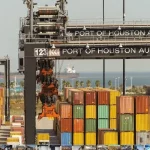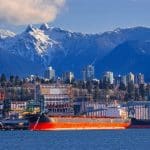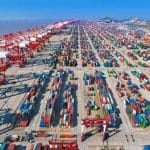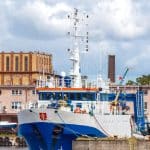HOUTHIS ASSERT ATTACKS IN MED AND RED SEA INCLUDING FIVE MISSILES AT A SHIP
The Houthis are asserting a broad array of attacks conducted on a range of ships in both the Mediterranean and the Red Sea, including a barrage at one vessel and targeting a Maersk vessel. Spokesperson Yahya Saree asserted all the attacks were for support of Israel or calling in Israeli ports while saying that Maersk, is “one of the most supportive companies” for Israel. Most of the attacks were uncorroborated by the U.S. or UK, which monitor the activities as part of their defense operations. The Houthis claimed attacks on two vessels in the Red Sea in their latest announcement. One the Delonix, a 20,600-dwt product carrier registered in Liberia they called an “American ship.” The ship is managed by Merman Maritime of Greece and bound from the Suez Canal to China. The other vessel in the Red Sea was identified as a bulk carrier Ioannes, which the Houthis said was targeted “by a number of uncrewed surface boats.” There are unconfirmed media reports that while Saudi Arabia’s Defense Minister Khaled bin Salman was meeting with Chinese officials this week he asked for their support with the Houthis. Reported suggested the Saudis might be seeking Chinese help to halt the attacks on ships heading to and departing from Saudi ports.
20 OF WORLD’S BIGGEST COMPANIES COLLABORATE TO MODERNIZE BAR CODE
After five decades, the neutral organization that oversees bar code usage, GS1 US, is working with regulators and brand leaders like Pepsico and Procter & Gamble to enhance product information within scalable technology. Amazon and Walmart, which are on the organization’s board, and Target, which is on its executive leadership committee, are also weighing in on how to transition from the bar code to the QR code. “The bar code is a huge part of our everyday life,” said Carrie Wilkie, SVP of standards and technology at GS1 US. “Bar codes are scanned ten billion times a day! But bar codes are one-dimensional, meaning it can only provide information moving from Point A to Point B. There are other types of bar codes being used like QR and DataMatrix codes which can provide access to additional information like product batch numbers, and granular information like serial numbers of medical devices so doctors and patients know exactly which product is being used, where it was manufactured, and when.” Wilkie said in addition to medical devices, QR codes could provide information on product recalls.

PANAMA CANAL ANNOUNCES SECOND SET OF RESTRICTION EASING IN JUNE
Through an Advisory to Shipping, the Panama Canal has announced that, effective June 26, the maximum authorised draught was raised to 14.33 metres (from 46 to 47 feet), and on July 11 will increase to 14.63 metres (48 feet). The latest updates build on improvements announced earlier in June, which included an increase in daily transits from 32 to 33 beginning on July 11, and again to 34 on July 22. This adjustment is anticipated to offer greater scheduling flexibility and alleviate some of the congestion issues that have plagued the canal in recent times due to a prolonged drought in the lakes which feed the waterway. The improved water levels and increased capacity are expected to streamline logistics and reduce delays, which have been a significant concern for global trade, exacerbated by the situation in the Red Sea. The Panama Canal Authority (ACP) which is celebrating 8 years of the expanded waterway, said its efforts demonstrate its commitment to maintaining the canal as a reliable and efficient route for global trade. The increased depth limits and additional transit slots are expected to play a pivotal role, accommodating larger vessels and heavier cargoes, thereby boosting the canal’s overall throughput and efficiency.
DALI LEAVES BALTIMORE FOR REPAIRS
With tugs by its side the Dali, this year’s most infamous ship, finally left Baltimore yesterday, some three months after it smashed into the city’s largest bridge. The ship will transit to Virginia International Gateway to offload approximately 1,500 containers to reduce draft, before moving to Norfolk International Terminal for repairs. The National Transportation Safety Board (NTSB) released an update regarding its investigation into the loss of power onboard the containership and its subsequent allision with the Francis Scott Key Bridge, an accident that cost the lives of six men working on the bridge on March 26. The NTSB has removed an insulated component that connects wires, called a terminal block, for testing in its materials lab. All vehicles were barred from the giant Chesapeake Bay Bridge as the Dali transited yesterday with helicopters overhead capturing the voyage for rolling news channels.




